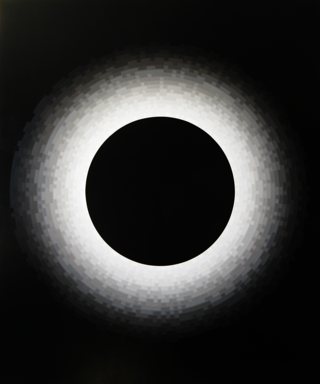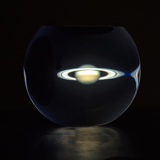Sky Lab (2013)
Latrobe Regional Gallery, Victoria 2013
Curator: Felicity Spear

Magda Cebokli Probability Monochrome Eclipse 2012
(Acrylic on canvas 101.5 x 122 cm)
Artists
- Daniel Armstrong
- Magda Cebokli
- Lesley Duxbury
- Sam Leach
- Harry Nankin
- Govinda Sah ‘Azad’ (Nepal)
- Felicity Spear
- Vanessa Stanley
- Tarja Trygg (Finland)
From a cosmic perspective science tells us that Earth is a totally insignificant speck of dust in an expanding Universe. We are made of that dust. So the story of the Universe is also our story. The artists represented in Sky Lab direct their gaze beyond our planet to create speculative works about our relationships to outer space and sky-situated knowledge.
In the depths of this space, in a blisteringly hot furnace at a temperature of 4.5 billion degrees, emerged the iron we see in cars, in buildings, and in our blood which at this very moment is flowing through our veins. We humans are carbon based bipeds. Life as we know it could not have begun without the formation of carbon, the physical basis of all living organisms. It is electronic data, remote sensing and computer simulations, which are allowing astronomers to examine and map the characteristic fingerprint or barcode which these elements reveal in the light coming from stars. This is the forensic evidence for our existence here on Earth. Our reality, once tangible for all our senses, is now understood as a pin point in an unfolding and much greater remote sensed reality.

Daniel Armstrong
Aqua Optica Saturn #2 2013
(mixed media)
But what if we Earthlings, travelling through the Universe on Spaceship Earth [1], are destined to cosmic solitary confinement with no one else to talk to and nowhere else to go? Projected space stations and dreams of bases on the Moon and Mars create the possibility of man escaping the confines of the Earth and becoming an inhabitant of the sky. Scientists are suggesting that it might even be possible one day to terra-form or Earth-shape by modifying the atmosphere of a planet like Mars, or a moon, in order to make it habitable for humans. Such propositions remind us that science fiction, which has conceived all kinds of alien life forms and possible worlds existing in other parts of the Universe, creates a rich imaginative culture about the Universe, out there.
What do we make of these cosmic signs in our everyday world? Do we see Earth as a planet, with all its complex biodiversity, or merely an amalgam of human-designated territories? Artists who are inspired by scientific interpretations of Nature are inevitably confronted with ecological concerns. Our knowledge of Nature (from the Latin physica) is increasingly understood through culture, the various customs and human intellectual activities in which our species, modern humans, homosapiens (from the Latin for wise-man) participate. But as our population overwhelms Earth’s resources and we manipulate and modify the natural world for our own ends, this blue planet, once seemingly resistant and infinite in its depth, may be headed for defeat at the hands of our own species, the so-called wise men.
Today our horizon has expanded exponentially. Increasingly technological sophistication has enabled us to survey and appreciate the structure of the Universe. Cosmic space is no longer understood as a clockwork mechanism and a quantity of discrete objects. Now it is thought of as a set of interacting processes and relational fields which challenge our understandings of what is meant by reality. The advancement of any branch of inquiry engenders new horizons, new choices and ethical challenges. As the astronomer John Barrow has observed, ‘We feel like the Universe’s only child and that feeling has many consequences.’ [2]
Felicity Spear 2013
1. A term suggested by Buckminster Fuller (1895-1983) philosopher, architect, systems theorist. Creator of the geodesic dome and the fullerene, a carbon molecule forming a hollow sphere, ellipsoid or tube resembling the geodesic dome and its hexagons.
2. John Barrow, The Artful Universe, (Clarendon Press, Oxford, 1995), pp 44.